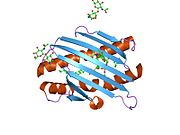Biology:Endothelial protein C receptor
 Generic protein structure example |
Endothelial protein C receptor (EPCR) also known as activated protein C receptor (APC receptor) is a protein that in humans is encoded by the PROCR gene.[1][2][3] PROCR has also recently been designated CD201 (cluster of differentiation 201).
The protein encoded by this gene is a receptor for protein C that enhances its activation. Protein C is an anti-coagulant serine protease activated by the blood coagulation pathway.
Structure
EPCR protein is an N-glycosylated type I membrane protein that enhances the activation of protein C.[3] It belongs to the MHC class I/CD1 family of proteins, that is characterized by having a deep groove, that in other proteins in the family (but not in EPCR) is usually used for antigen binding.
Like the CD1 series, EPCR has a lipid in the corresponding groove. The bound lipid in EPCR is usually phosphatidylcholine, but it may be phosphatidylethanolamine, and it contributes to protein C binding, though probably not through direct contact [4]
Clinical significance
Mutations in this gene have been associated with venous thromboembolism and myocardial infarction, as well as with late fetal loss during pregnancy.[3]
The protein is also involved in Plasmodium falciparum malaria as subtypes of the Plasmodium falciparum erythrocyte membrane protein 1 (PfEMP1) family use EPCR of the host as a receptor.[5]
References
- ↑ "Identification, cloning, and regulation of a novel endothelial cell protein C/activated protein C receptor". J Biol Chem 269 (42): 26486–91. Nov 1994. doi:10.1016/S0021-9258(18)47220-1. PMID 7929370.
- ↑ "One single mRNA encodes the centrosomal protein CCD41 and the endothelial cell protein C receptor (EPCR)". FEBS Lett 458 (1): 77–80. Oct 1999. doi:10.1016/S0014-5793(99)01074-1. PMID 10518938.
- ↑ 3.0 3.1 3.2 "Entrez Gene: PROCR protein C receptor, endothelial (EPCR)". https://www.ncbi.nlm.nih.gov/sites/entrez?Db=gene&Cmd=ShowDetailView&TermToSearch=10544.
- ↑ Esmon CT (May 2004). "Structure and functions of the endothelial cell protein C receptor". Critical Care Medicine 32 (5 Suppl): S298-301. doi:10.1097/01.CCM.0000126128.64614.81. PMID 15118534.
- ↑ "Severe malaria is associated with parasite binding to endothelial protein C receptor". Nature 498 (7455): 502–5. 2013. doi:10.1038/nature12216. PMID 23739325. Bibcode: 2013Natur.498..502T.
Further reading
- Esmon CT (2004). "Coagulation and inflammation.". J. Endotoxin Res. 9 (3): 192–8. doi:10.1179/096805103125001603. PMID 12831462.
- "Specificity of coagulation factor signaling.". J. Thromb. Haemost. 1 (7): 1495–503. 2003. doi:10.1046/j.1538-7836.2003.00300.x. PMID 12871285.
- "Thrombomodulin-protein C-EPCR system: integrated to regulate coagulation and inflammation.". Arterioscler. Thromb. Vasc. Biol. 24 (8): 1374–83. 2005. doi:10.1161/01.ATV.0000134298.25489.92. PMID 15178554.
- "Polymorphisms in the endothelial protein C receptor gene and thrombophilia.". Thromb. Haemost. 98 (3): 564–9. 2007. doi:10.1160/th07-01-0071. PMID 17849044.
- Raheja KK (1977). "Nursing in transition.". Nursing Forum 15 (4): 413–7. doi:10.1111/j.1744-6198.1976.tb01065.x. PMID 1051893.
- "Human protein C receptor is present primarily on endothelium of large blood vessels: implications for the control of the protein C pathway.". Circulation 96 (10): 3633–40. 1998. doi:10.1161/01.cir.96.10.3633. PMID 9396465.
- "The endothelial cell protein C receptor (EPCR) functions as a primary receptor for protein C activation on endothelial cells in arteries, veins, and capillaries.". Biochem. Biophys. Res. Commun. 259 (3): 671–7. 1999. doi:10.1006/bbrc.1999.0846. PMID 10364477.
- "Structural and functional implications of the intron/exon organization of the human endothelial cell protein C/activated protein C receptor (EPCR) gene: comparison with the structure of CD1/major histocompatibility complex alpha1 and alpha2 domains.". Blood 94 (2): 632–41. 1999. doi:10.1182/blood.V94.2.632. PMID 10397730.
- "Organization and chromosomal localization of the human endothelial protein C receptor gene.". Gene 238 (2): 367–73. 1999. doi:10.1016/S0378-1119(99)00360-1. PMID 10570964.
- "Mechanisms by which soluble endothelial cell protein C receptor modulates protein C and activated protein C function.". J. Biol. Chem. 275 (8): 5447–52. 2000. doi:10.1074/jbc.275.8.5447. PMID 10681521.
- "Metalloproteolytic release of endothelial cell protein C receptor.". J. Biol. Chem. 275 (8): 6038–44. 2000. doi:10.1074/jbc.275.8.6038. PMID 10681599.
- "Identification of the protein C/activated protein C binding sites on the endothelial cell protein C receptor. Implications for a novel mode of ligand recognition by a major histocompatibility complex class 1-type receptor.". J. Biol. Chem. 276 (11): 8364–70. 2001. doi:10.1074/jbc.M010572200. PMID 11099506.
- "A 23bp insertion in the endothelial protein C receptor (EPCR) gene impairs EPCR function.". Thromb. Haemost. 86 (4): 945–8. 2002. PMID 11686350.
- "Characterization of protein C receptor expression in monocytes.". Br. J. Haematol. 115 (2): 408–14. 2001. doi:10.1046/j.1365-2141.2001.03187.x. PMID 11703343.
- "Prevalence of a 23bp insertion in exon 3 of the endothelial cell protein C receptor gene in venous thrombophilia.". Thromb. Haemost. 86 (6): 1360–2. 2002. PMID 11776299.
- "The DNA sequence and comparative analysis of human chromosome 20.". Nature 414 (6866): 865–71. 2002. doi:10.1038/414865a. PMID 11780052. Bibcode: 2001Natur.414..865D.
- "The crystal structure of the endothelial protein C receptor and a bound phospholipid.". J. Biol. Chem. 277 (28): 24851–4. 2002. doi:10.1074/jbc.C200163200. PMID 12034704.
- "Activation of endothelial cell protease activated receptor 1 by the protein C pathway.". Science 296 (5574): 1880–2. 2002. doi:10.1126/science.1071699. PMID 12052963. Bibcode: 2002Sci...296.1880R.
External links
- Overview of all the structural information available in the PDB for UniProt: Q9UNN8 (Endothelial protein C receptor) at the PDBe-KB.
This article incorporates text from the United States National Library of Medicine, which is in the public domain.
 |



